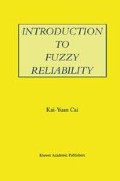Abstract
As well-known, the problem of street-lighting replacement is one of the most early problems approached in the context of reliability. In 1941 N.R.Campbell formulated the problem of street-lighting lamps replacement as follows: N street-lighting posts have to be provided continually with (functioning) lamps [8]. This implies that the lighting system is modeled as a series system with N components (lamps) and a new lamp has to be taken to replace the failed lamp upon failure. Unfortunately, this doesn’t coincide with reality. The situation often comes to us that some of the street-lighting lamps fail but are not replaced immediately. This implies that some failed lamps may be tolerable in the lighting system as long as the total light output of the system keeps to an acceptable level. So Campbell’s modeling of the lighting system as a series system is no longer appropriate. The system states should be determined in the context of the total light output rather than the number of functioning lamps directly, though some relation may exist between them. Then what is the system state, functioning or failed, if there are two failed lamps and N - 2 functioning lamps in the system? And what is the system state if there are N - 2 failed lamps and 2 functioning lamps in the system? The answers are fuzzy. Fuzzy methodology should be employed to define the system states when the lighting system is required to provide an acceptable level of the total light output, since fuzziness is attached to the term ‘acceptable’ [3]. We can treat the lighting system as a profust system.
Access this chapter
Tax calculation will be finalised at checkout
Purchases are for personal use only
Preview
Unable to display preview. Download preview PDF.
References
R.E. Barlow, F. Proschan, Mathematical Theory of Reliability, John Wiley & Sons, 1965.
J.S. Bynes, R.C. Angell, “The Dependency Model: A Tool for Calculating System Effectiveness”, IEEE Transactions on Reliability, Vol.R-34, No.1, 1985, pp17–24.
K.Y. Cai, C.Y. Wen, “Street-Lighting Lamps Replacement: A Fuzzy Viewpoint”, Fuzzy Sets and Systems, Vol.37, 1990, pp161–172.
K.Y. Cai, C.Y. Wen, Z.J. Chen, “A Preliminary Analysis of CIMS Reliability with Fuzzy Viewpoint”, Proc. Beijing International Conference on System Simulation and Scientific Computing, 1989, pp771–775.
K.Y. Cai, Z. Li, P.Q. Li, “Profust Reliability Analysis of Fly-by-Wire System for an ACT Test Aircraft”, Chinese Journal of Aeronautics, Vol.6, No.4, 1993, pp302–313.
K.Y. Cai, C.Y. Wen, M.L. Zhang, “Fuzzy Reliability Modeling of Gracefully Degradable Computing Systems”, Reliability Engineering and System Safety, Vol.33, 1991, pp141–157.
K.Y. Cai, C.Y. Wen, M.L. Zhang, “Survivability Index for CCNs: A Measure of Fuzzy Reliability”, Reliability Engineering and System Safety, Vol.33, 1991, pp71–99.
N.R. Campbell, “The Replacement of Perishable Members of a Continually Operating System”, Journal of Royal Statistical Society, Vol.7, No.2 1941, pp110–130.
H. Frank, I.T. Frisch, “Analysis and Design of Survivable Networks”, IEEE Transactions on Communication Technology, Vol.COM-18, No.5, 1970, pp501–519.
Z. Li, “Failure Modes and Effect Analysis of FBW System for an ACT Test Aircraft”, B.S. Thesis, (in Chinese), Beijing University of Aeronautics and Astronautics, 1990.
Q.Z. Mei, J.S. Liao, H.Z. Sun, Fundamentals of System Reliability Engineering, (in Chinese), Science Press, Beijing, 1987, p156.
R.E. Merwin, M. Mirhakak, “Derivation and Use of a Survivability Criterion for DDP Systems”, Proc. National Computer Conference, USA, 1980, pp139–146.
S.M. Ross, Stochastic Processes, John Wiley & Sons, 1983.
P.Z. Wang, Fuzzy Set Theory and Its Applications, Shanghai Science and Technology Press (in Chinese), 1983.
Y. Watanabe, “Errors in Availability Estimation by 2-State Models of 3-State Systems”, Reliability Engineering, Vol.18, 1987, pp223–235.
Author information
Authors and Affiliations
Rights and permissions
Copyright information
© 1996 Kluwer Academic Publishers
About this chapter
Cite this chapter
Cai, KY. (1996). Profust Reliability Behavior of Engineering Systems. In: Introduction to Fuzzy Reliability. The Kluwer International Series in Engineering and Computer Science, vol 363. Springer, Boston, MA. https://doi.org/10.1007/978-1-4613-1403-5_5
Download citation
DOI: https://doi.org/10.1007/978-1-4613-1403-5_5
Publisher Name: Springer, Boston, MA
Print ISBN: 978-1-4612-8608-0
Online ISBN: 978-1-4613-1403-5
eBook Packages: Springer Book Archive

